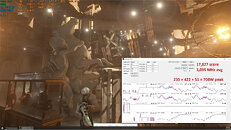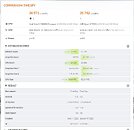- Joined
- Oct 9, 2007
- Messages
- 47,670 (7.43/day)
- Location
- Dublin, Ireland
| System Name | RBMK-1000 |
|---|---|
| Processor | AMD Ryzen 7 5700G |
| Motherboard | Gigabyte B550 AORUS Elite V2 |
| Cooling | DeepCool Gammax L240 V2 |
| Memory | 2x 16GB DDR4-3200 |
| Video Card(s) | Galax RTX 4070 Ti EX |
| Storage | Samsung 990 1TB |
| Display(s) | BenQ 1440p 60 Hz 27-inch |
| Case | Corsair Carbide 100R |
| Audio Device(s) | ASUS SupremeFX S1220A |
| Power Supply | Cooler Master MWE Gold 650W |
| Mouse | ASUS ROG Strix Impact |
| Keyboard | Gamdias Hermes E2 |
| Software | Windows 11 Pro |
An AMD Radeon RX 7900 XTX graphics card is capable of trading blows with NVIDIA GeForce RTX 4090, as overclocker jedi95 found out. With its power limits unlocked, the RX 7900 XTX was found reaching engine clocks as high as 3.46 GHz, significantly beyond the "architected for 3.00 GHz" claim AMD made in its product unveil last Fall. At these frequencies, the RX 7900 XTX is found to trade blows with the RTX 4090, a segment above its current segment rival, the RTX 4080.
Squeezing 3.46 GHz out of the RX 7900 XTX is no child's play, jedi95 used an Elmor EVC2SE module for volt-modding an ASUS TUF Gaming RX 7900 XTX, essentially removing its power-limit altogether. He then supplemented the card's power supply, so it could draw as much as 708 W (peak), to hold its nearly 1 GHz overclock. A surprising aspect of this feat is that an exotic cooling solution, such as liquid-nitrogen evaporator, wasn't used. A full-coverage water block and DIY liquid cooling did the job. The feat drops a major hint at how AMD could design the upcoming Radeon RX 7950 XTX despite having maxed out the "Navi 31" silicon with the RX 7900 XTX. The company could re-architect the power-supply design to significantly increase power limits, and possibly even get the GPU to boost to around the 3 GHz-mark.




View at TechPowerUp Main Site | Source
Squeezing 3.46 GHz out of the RX 7900 XTX is no child's play, jedi95 used an Elmor EVC2SE module for volt-modding an ASUS TUF Gaming RX 7900 XTX, essentially removing its power-limit altogether. He then supplemented the card's power supply, so it could draw as much as 708 W (peak), to hold its nearly 1 GHz overclock. A surprising aspect of this feat is that an exotic cooling solution, such as liquid-nitrogen evaporator, wasn't used. A full-coverage water block and DIY liquid cooling did the job. The feat drops a major hint at how AMD could design the upcoming Radeon RX 7950 XTX despite having maxed out the "Navi 31" silicon with the RX 7900 XTX. The company could re-architect the power-supply design to significantly increase power limits, and possibly even get the GPU to boost to around the 3 GHz-mark.




View at TechPowerUp Main Site | Source







